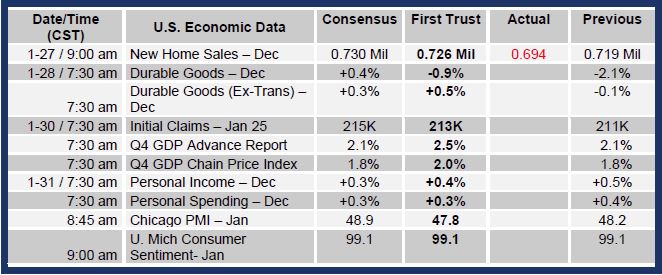Brian Wesbury Weekly Outlook
28.01.2020 16:45 - First Trust Global Portfolios Limited

Look for Steadiness from the Fed
The Federal Reserve is set to make its first policy statement of the year on Wednesday, so this is as good a time as any to reiterate our view that the Fed is likely to keep short-term interest rates steady through 2020 and, while pressures will build, the Fed seems content to hold them steady next year, as well.
We still think monetary policy is far from tight, and the economy could easily withstand higher short-term rates. Nominal GDP – real GDP growth plus inflation – is up 3.8% from a year ago, and up at a 4.8% annual rate in the past two years, figures consistent with higher short-term rates.
But the Fed is very unlikely to raise rates given its fear of an inverted yield curve, its desire to see a period of inflation in excess of 2.0%, and its propensity to always find something going on elsewhere in the world that could, at least theoretically, lead to slower growth. Last year it was political wrangling over Brexit, fears of a trade war with China, and slower growth abroad. This year it could be Brexit again, and perhaps the coronavirus coming from China.
Meanwhile, with equities so much higher than a year ago and the economy growing at a moderate pace, the Fed will lack a justification for cutting rates.
In the background, the Fed is likely to continue to gradually increase the size of its balance sheet via repurchase operations after having (temporarily) ended Quantitative Easing in October 2014 and reducing the balance sheet (Quantitative Tightening) starting in late 2015. The Fed restarted QE (without calling it that) near the end of last year, but even with the recent increases, the balance sheet finished 2019 at $4.13 trillion, still below the $4.45 trillion it hit during QE3.
And yet the S&P 500 is up 66% since the end of QE. By contrast, the Euro STOXX 50 is up only 25%.
What makes this so important is that it flies in the face of the theory that QE is behind the increase in equity prices. While the Fed pulled back, the European Central Bank continued expanding its balance sheet and even implemented negative interest rates in an attempt to stimulate the Eurozone economy. If QE and negative rates were so powerful, it should be US equities that lagged, not European equities.
It also suggests the Fed doesn’t need to be gradually expanding its balance sheet again. There were still $1.49 trillion in excess reserves in the financial system at the end of 2019, and the banking system is far better capitalized than it was before the financial crisis.
When short term interest rates started periodically spiking upward in mid-September, the Fed had three possible courses of action. First, it could have let the free market work. No banks were going bust because of a temporary lack of liquidity; it just meant those in need of liquidity had to pay a high price so they wouldn’t run afoul of tough financial regulations. Maybe some financial institutions needed to unwind positions that ate up cash.
Second, the government could have adjusted the very stringent liquidity regulations put in place after the financial crisis. These rules lead to temporary shortages of reserves when companies remove deposits to make large tax payments, participate in large Treasury auctions, or, when hedge funds attempt to borrow more money from banks. Loosening the rules would have quickly made more cash available!
Or third, the Fed could decide to start increasing its balance sheet again because that would increase its power.
Of course, the Fed picked Door #3. In the end, it behaved in just as self-interested a way as people do in the private sector. Except policymakers are doing it with other people’s money, not their own. We don’t agree with more QE, but the Fed will not get in the way of a continued economic recovery.
Brian S. Wesbury - Chief Economist
Robert Stein, CFA – Deputy Chief Economist
